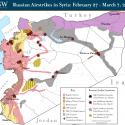 |
 |
Russian Airstrikes in Syria: February 27 - March 7, 2016
Mar 10, 2016 - Genevieve Casagrande


Russian airstrikes continue to target mainstream elements of the Syrian armed opposition, despite the ongoing cessation of hostilities agreement. The Syrian Observatory for Human Rights reported that the level of violence in the country has decreased by ninety percentsince the onset of the agreement on February 27. Pro-regime forces supported by Russian airstrikes nevertheless continued operations to clear opposition-held terrain in Latakia Province in an effort to buffer the regime’s coastal stronghold. Jaysh al-Nasr, a coalition of FSA-affiliated opposition factions that includes prominent U.S.-backed TOW anti-tank missile recipients, reported Russian airstrikes near the opposition’s frontlines with the regime in the al-Ghab Plain, which lies on Latakia’s eastern border. Russian warplanes also conducted limited strikes against the armed opposition in other areas of western Syria from February 29 - March 7, including the first reported Russian airstrikes in Damascus Province since the cessation of hostilities agreement began. The likely continuation of limited Russian airstrikes against mainstream elements of the opposition ultimately threatens the sustainability of any ceasefire agreement and the outcome of upcoming negotiations between the regime and the opposition in Geneva, currently scheduled to resume on March 14. The opposition High Negotiations Committee (HNC) continues to report Russian and regime violations of the cessation of hostilities agreement, which included a total of 90 airstrikes carried out by Russian and regime warplanes as of March 4. The HNC has yet to make a decision regarding its attendance of the talks. Prominent HNC member Riad Nassan Agha stated on March 8 that their “inclination is to go,” but remains dependent upon the degree to which the regime and its allies maintain the cessation of hostilities.
Russia’s decrease in airstrikes against the armed opposition in western Syria has likely allowed Russian air operations to increase support to the regime’s limited operations against ISIS. Russian air operations have notably decreased in areas such as Aleppo, where heavy strikes have been maintained for the first five months of Russia’s air campaign. Russian airstrikes concentrated against ISIS’s positions in and around Palmyra in central Homs Province amidst a concerted regime effort to breach the town on March 7. Regime ground operations in Palmyra were ultimately unsuccessful, highlighting the regime’s continued limitations in combating ISIS as the regime and its allies remain preoccupied with the defeat of the Syrian armed opposition.
The following graphic depicts ISW’s assessment of Russian airstrike locations based on reports from local Syrian activist networks, Syrian state-run media, and statements by Russian and Western officials. This map represents locations targeted by Russia’s air campaign, rather than the number of individual strikes or sorties.
High-Confidence reporting. ISW places high confidence in reports corroborated both by official government statements reported through credible channels and documentation from rebel factions or activist networks on the ground in Syria deemed to be credible.
Low-Confidence reporting. ISW places low confidence in secondary sources that have not been confirmed or sources deemed likely to contain disinformation.